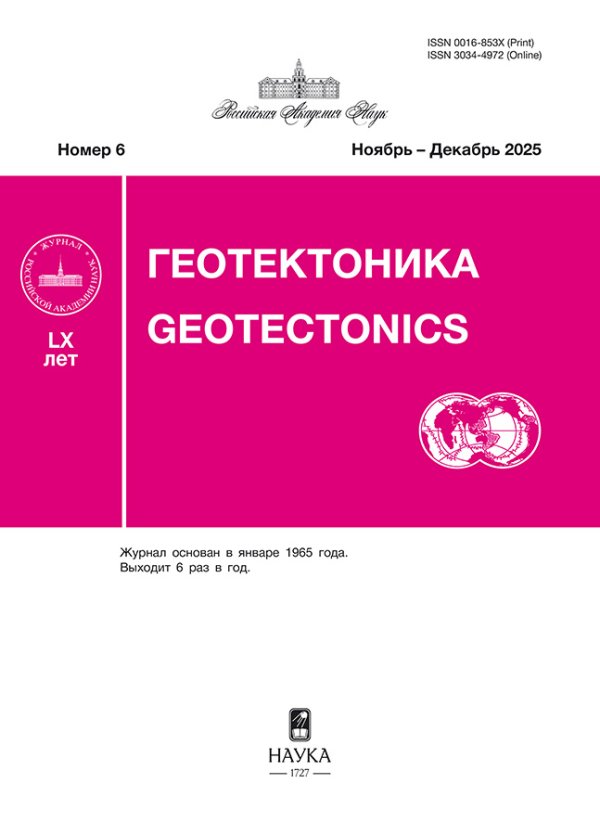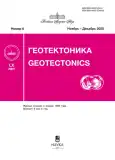Geotectonics
ISSN (print): 0016-853Х
Founder: Russian Academy of Sciences
Editor-in-Chief: Kirill Evgenyevich Degtyarev, Academician of the Russian Academy of Sciences
Frequency / Access: 6 issues per year / Subscription
Included in: White List (1st level), Higher Attestation Commission List, RISC
Media registration certificate: No. 0110282 dated 02/08/1993
Ағымдағы шығарылым
№ 6 (2025)
Articles
Paleo- and Mesoproterozoic Complexes of the Ulutau Terrane (Central Kazakhstan): Structure, Age Substantiation and Position in the Nuna Supercontinent
Аннотация
The article presents the results of studying and substantiating the age (SHRIMP II, LA-ICP-MS) of Paleo- and Mesoproterozoic sedimentary and volcanogenic-sedimentary complexes of the Ulutau Terrane in the west of Central Kazakhstan. Paleoproterozoic formations are represented by quartzites and shales of the Kumolinskaya Formation with a maximum sedimentation age of 2.03 Ga. These formations, including the terrigenous sequences of the Chuy-Kendyktas and Issykul terranes, mark the oldest stage of accumulation of mature sedimentary sequences in the western part of the Central Asian belt, associated with the opening of rift basins within the Nuna Supercontinent during the post-collisional stretching stage. The Mesoproterozoic formations include the bimodal volcanic-sedimentary association of the Zhidinsky Series (~1326–1367 Ma), which is associated with the Ectasian stage of riftogenic magmatism that accompanied the breakup of the Nuna supercontinent. The data obtained suggest that in the Paleo- and Mesoproterozoic, the Ulutau Terrane, the Tarim Craton, and the Yangtze Craton had a similar evolution related to intra-plate tectono-magmatic processes in the western and northwestern parts of the Nuna Supercontinent.
 3-30
3-30


Structural Evolution and Deformation Stages of the Middle-Late Paleozoic Collisional Complexes of the Paleooceanic Sector of the Southern Urals
Аннотация
The structural studies of the structural-formational zones of the paleoceanic sector of the Southern Urals were conducted in detail. The formation sequence of mesostructural parageneses was established, allowing us to reconstruct the structural evolution of the region and develop a new model based on the metamorphic features of the East Ural megazone, in which the megazone is part of the Magnitogorsk island-arc system. The Magnitogorsk island-arc is partially ensialic and partially ensimatic. In the structural evolution of the paleooceanic sector of the Southern Urals during Middle-Late Paleozoic collisional events, D1 and D2 deformation stages were identified. The first stage of deformation, D1, was expressed in the formation of west-vergent isoclinal folds in the west of the Magnitogorsk megazone and east-vergent folds in its east. In the East Ural megazone, southeast- and west–southwest-vergent folds formed during the stage D1. The stage D1 marked the oblique sinistral collision of the Magnitogorsk island arc with the margin of the Baltica paleocontinent at the end of the Devonian. As a result of deformations occurring under sinistral transpression, a bivergent “palm tree” structure formed in the Southern Urals during the stage D1, with the formation of west-vergent F1 folds (in the Aktau-Tanalyk zone) and east-vergent folds (in the eastern West Magnitogorsk and East Magnitogorsk zones), as well as southeast- and west–southwest-vergent folds (within the East Ural megazone). The second stage of deformation, D2, was associated with the late Paleozoic Ural intercontinental collision at the end of the Middle Carboniferous–Permian. The stage D2 marked the completion of the Main Ural Fault zone and the formation of north–west-vergent F2 folds in the Aktau-Tanalyk zone. The stage D2 includes the formation of west- and northwest-vergent folds in the East Mugodzhar megazone and all structures of the Trans-Ural megazone. The formation of late, predominantly sinistral strike-slip folds with steeply dipping hinges corresponded to the stage of post-collisional strike-slip movements that completed the structural and geodynamic evolution of the Ural Paleoocean.
 31-62
31-62


Structure of the Proterozoic Complex of the Kama-Belsky Trough (North-East of the Russian Platform): Conditions of Formation, Filtration and Capacity Properties of Rocks, Parameters for Modeling of Migration and Accumulation Processes
Аннотация
The article discusses the structural and tectonic features of the Riphean-Vendian section of the Kama-Belsky Trough. It is shown that its formation is determined by the layered-block (up to a depth of 3500 m) and block (at a depth of more than 3,500 m) geofiltration structure of the Proterozoic section. Based on the analysis of the lithological composition of the deposits of the Kama-Belsky Trough, the following were identified: (i) regionally developed lateral conductive strata, (ii) low-permeability strata with subordinate development of reservoirs, and (iii) subvertical permeable zones. In addition, well-defined potentially lateral conductive strata are identified in the Riphean (Rotkovskaya, Tukaevskaya, and Leonidovskaya formations) and Vendian (Baikibashevskaya (Kykvinskaya) formation) deposits. Based on the results of laboratory studies of 1,600 core samples, a range-based assessment of the filtration and capacity properties of the most typical lithotypes of Proterozoic rocks was performed. A comprehensive assessment of the filtration and capacity properties of rocks was conducted, including (i) empirical dependencies, (ii) the fractional lithological composition of objects, and (iii) the analysis of lithotypes taking into account the layered-ordered and layered-disordered structures. To carry out modeling of migration-accumulation processes in the factor-range formulation, expert parameters of permeability for various lithotypes of rocks are introduced. The assessment of the weighted average permeability and the comparison of the calculation results are carried out on the basis of the sections of individual wells with the subsequent generalization for the territorial zones of the Kama-Belsky depression. As an example, the calculation of the permeability range of geofiltration elements for a model of layered-ordered and layered-disordered lithological structure of the formation based on the data from the Arlanskaya-7000 well is presented.
 63-84
63-84


Tectonophysical Zoning of Active Faults in Altai-Western Sayan Region: Identification of Locations for Preparation of Strong Earthquakes
Аннотация
Tectonophysical zoning of active faults according to the level of Coulomb stresses for Alati-Western Sayan region has been performed. The source of stress data is the mechanisms of earthquake foci and a modified algorithm for the method of cataclastic analysis of discontinuous displacements, implemented in the new computer program STRESSseism_v.3.0. Based on the results of stress reconstruction, the kinematic types of regional faults and the angles of their immersion in the upper crust (5-15 km) have been clarified. Five zones have been identified with fault systems having a high level of Coulomb stresses with the length of dangerous fault sections exceeding 50-70 km. The obtained result is considered as a deterministic long-term forecast of the preparation zones for strong earthquakes with magnitudes M >= 6.5-7.0 and, possibly, with higher magnitudes.
 85-118
85-118












